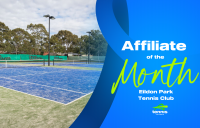26 June 2014 | Tennis Victoria
Marc McGowan of Aceland Tennis caught up with the 2013/14 Victorian Spirit of Tennis Winner, Daniela Di Toro.
Blessed was Daniela Di Toro’s go-to word as a cavalcade of admirers congratulated her on Monday night.
Di Toro, the infectiously enthusiastic former world No.1 wheelchair tennis player, arrived at Tennis Victoria’s Championships Dinner for what she thought was a typical speaking engagement.
She fulfilled that part of the night with her usual wit, charm and warmth. But her night, unbeknown to her, was only just getting started.
Di Toro, who turns 40 in October, was announced as the 34th recipient of the Victorian Spirit of Tennis award.
Frank Sedgman and Colin Stubs, the inaugural 1980 and 2013 winners, respectively, presented her with it.
The award recognises a person who has made a significant and valuable contribution to the advancement of the sport in any field.
Di Toro was gobsmacked.
“You read those names (of previous winners) and that’s royalty there,” Di Toro said.
“Everyone from Judy Dalton – let’s just smash a bunch of barriers right there – and a bunch of men who have had a real influence on my world, like Neale Fraser.
“Holy crap, he’s pretty much like my granddad. I would see him around Melbourne Park all the time.
“And Allan Stone. I hit balls with Allan for a number of years while I was between coaches.”
Only the fact her name was already marked on the honour board could convince Di Toro this was being bestowed upon her.
This was the same girl who, at age 13, had her life turned upside down when a brick wall at a Dandenong pool collapsed on her as she competed in a school swimming carnival.
The tragic accident left Di Toro a paraplegic.
But a sereneness she experienced immediately afterwards was the first sign she was going to be okay.
“There were 300 kids and all you hear is screaming and all I could think of was, ‘I’m so glad I’m not that chick’,” Di Toro said.
“I felt like it was under control. I knew I’d done some serious damage, but I felt like, ‘It’s going to be all right’.
“From a lot of the noises around me, it sounded like people were in a lot worse situation than I was.”
Except they weren’t. Thirty St John’s Regional College students were injured, but none worse than Di Toro.
She was unsure, speaking this week, whether her resilience came before or after that fateful March day in 1988, but, either way, she was Australian Open champion by 1991.
It was incredibly the first of nine Australian Open titles in a row Di Toro claimed and she finished with 10 overall from 24 appearances at the tournament.
Tennis provided a beacon of hope for Di Toro in a time of uncertainty after the accident.
She first played the sport as an eight-year-old and was a member at St Paul’s Apostle Tennis Club in Endeavour Hills, where she grew up.
But, being an active kid, Di Toro also dabbled in other sports, such as basketball and athletics.
“You keep getting told in hospital what you can’t do when you’re in my position and what you’re never going to do and what’s changed,” she said.
“But here was an opportunity to get back on a tennis court and feel like I can still volley, I can still serve and I can still hit a forehand.
“That was such a powerful moment in realising there are so many opportunities still available to me.”
There were other powerful moments.
One was meeting the late Sandy Blythe, who captained Australia’s wheelchair basketball team.
Another was realising how fortunate she was. Yep, fortunate.
“I could have been born in so many other parts of the world and never seen the light of day and that was really evident to me early on,” Di Toro said.
“(Having a positive attitude) just stops you wallowing a bit in self-pity and projecting anger and all this stuff onto other people.
“All of those emotions are totally justified, but I just got that it wasn’t useful.”
Di Toro was quick to point out there were dark times, when she was “totally flailing around”, but was never interested in feeling sorry for herself.
Not even as a 13-year-old.
Di Toro, who spent a decade working in youth services before becoming a Chinese medicine practitioner, saw it as just another experience rather than a chance to wallow.
She set about working extremely hard to become the best tennis player she could be and rose to the top of the game.
Di Toro is a five-time Paralympian and won each of wheelchair tennis’ four biggest events, the Australian, British, Japan and US opens.
“The time I was No.1 in the world, it was a time when five or six women could win any tournament for those three years,” she said.
“It’s easy to get to No.1, but it’s really hard to stay there.
“I’m a pretty social human being and I like an atmosphere and being able to have a chat and when you get to No.1 everyone starts weirdly hating you.
“It’s a really different environment, so I was pleased to be able to navigate my way through that and I’ve just met so many amazing people along the way.”
But Di Toro’s impact on the sport goes beyond even her seemingly endless achievements.
She played a leading role in wheelchair tennis’ growth and development, including it being held at Wimbledon for the first time – doubles only – and aligning itself with all four grand slams.
“Wimbledon was a big one, because we worked so hard to get there and it took so long to be there and the presence of wheelchair tennis at all the grand slams is a highlight for me,” Di Toro said.
“The Australian Open was the first that brought in the top eight men and women wheelchair tennis players and we kind of took that a bit for granted.
“Being present to those tournaments was so satisfying in the sense that so many people had worked so hard for so long and I got to really appreciate the moment for what it was.”
That role is not over, either.
Di Toro, who lives in Brunswick these days, is talking with Tennis Australia about increasing her involvement in the sport.
“I’ll definitely do some mentoring and they’ve got some things that are bubbling away in terms of just the role of disability in the broader picture,” she said.
“That’s definitely where I’ve been at for a long time in trying to create a level playing field for anyone with a disability.
“It’s about offering the opportunity that if anyone wants to work really hard, that there’s a place to do that and supports it on every level.
“It’s really exciting for me to be a part of that move forward.”
And further proof she is a worthy winner of the Victorian Spirit of Tennis award.
Marc McGowan is a tennis journalist who is passionate about the promotion of tennis at all levels. To see this and many other great articles on Australian tennis visit acelandtennis.com.au




